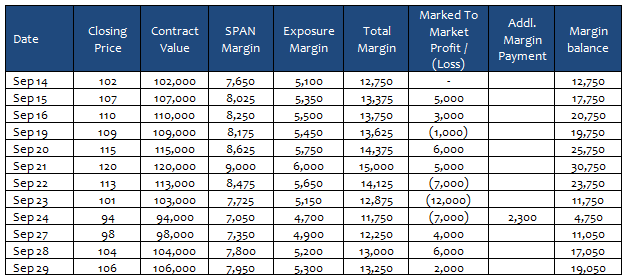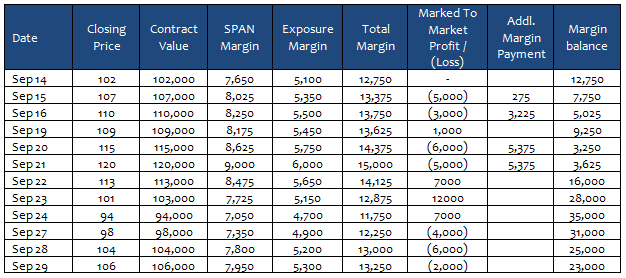Demystifying Derivatives: Margin and risk capital for futures contract

Derivatives are very important instruments in capital markets. However, most retail investors do not have a good understanding of these instruments. I have seen some of my friends and relatives trading in derivatives without understanding them. In most cases they made big losses; sometimes even more than the money they invested. If you do not understand derivatives, you should not trade in futures and options. However, even if you are not trading in derivatives, if you have a good understanding of these instruments, your knowledge of capital markets will improve substantially, which will help you become a smarter investor.
In our post, Demystifying Derivatives: Basics of Futures and Options Part 1, we had discussed what futures and options are, and understood, at a very basic level, how they work. It is important to understand the basics of futures and options very clearly, because there are significant differences between derivatives and shares or mutual funds. However, just understanding the basics does not arm you with sufficient knowledge to start trading in Futures and Options.
In this post and the next one, we will discuss two closely related important considerations in F&O trading, Margin and Risk Capital. Before we discuss further, I should tell you that, we will try to understand the concept of margin in F&O with the help of examples. Unfortunately, in finance and investments, when we discuss practical examples, we have to talk in terms of numbers. Mathematics comes naturally to some people, while for others it can be a bit overwhelming. For readers, who are not mathematically inclined, let me assure you that, there are no complex formulae in this post. All the calculations are basic arithmetic; all you require is a bit of patience and clear understanding of the basic concept.
Margin in Futures trading
In futures and options, you can buy or sell large amounts of securities using a relatively smaller amount of capital. Your broker will require you to put a certain percentage of the position you are taking in futures and options as margin with the broker. Understanding margins is the most important aspect of futures and options trading. Let us understand with the help of an example. Suppose you want to buy 1 lot of Axis Bank futures of September series (expiry September 29, 2016). Current market price of Axis Bank shares in cash or spot market is र 599, while price of Axis Bank futures is र 602. The difference between the spot price and futures, as explained in Demystifying Derivatives: Basics of Futures and Options Part 1, is the futures premium. Lot size of Axis Bank futures is 1,200. To buy 1 lot of Axis Bank futures, your broker may require you to pay an initial margin of र 90,000 (this is just a rough estimation; it will differ from broker to broker).
You should know that, margin is always a percentage of contract value. The initial margin has two components, SPAN margin and exposure margin. The SPAN margin of a security is specified by the stock exchange and has to be always maintained throughout the life of the future contract (i.e. till you close your position). SPAN margin is also sometimes known as Maintenance Margin. In the case of Axis Bank futures, the SPAN margin is 7.5% of the contract value. The contract value is approximately र 7.2 Lakhs. 7.5% of र 7.2 Lakhs is around र 54,000. However, your broker will ask you to pay an additional amount, known as the exposure margin. You can think of exposure margin as a cushion to protect the broker from marked to market losses.
You bought 1 lot of Axis Bank futures (lot size of 1,200) with a margin of just र 90,000. On the other hand, if you buy 1,200 Axis Bank shares in the spot market, you will have to invest nearly र 7.2 lakhs. You can see that, with futures, you can take a large position with a much smaller amount of capital. This is known as leverage. If Axis Bank share price rises र 20 by expiry your profit will be र 24,000 (20 X 1,200). You will book this profit by squaring off your position (selling Axis Bank futures). This profit will be credited to your trading account ledger by your broker, when you square off your future position. The benefit of leverage is obvious; you can make big profits with relatively small capital. However, leverage is a double edged sword. If instead of rising, the share price falls by र 20 by expiry your loss will be र 24,000 (20 X 1,200). The loss will be deducted from your initial margin and you will be left with less money.
You should understand the concept of Marked to Market very well, when trading in futures and options. In Demystifying Derivatives: Basics of Futures and Options Part 1, we had discussed futures and options are marked to market, or in other words they are re-priced with changes in the spot price (remember derivatives derive their value from the value of the underlying asset). Since the contract value is marked to market, the margin requirements (SPAN and Exposure margins) also change with changes in market price and contract value.
Let us understand this with the help of an example. Let us assume that, you buy a futures contract of September series of Scrip A. Lot size of futures contract is 1,000. Current Market Price (CMP) of Scrip A is र 100. Futures price of A is र 102. SPAN margin specified by the exchange for “A” futures contract is 7.5%. Your broker charges 5% exposure margin. Your contract value is र 1.02 Lakhs (102 X 1,000). Therefore, the broker will require you to pay an initial margin of र 12,750 (7.5% X 102,000 + 5% X 102,000). The table below shows the daily price movement of A, Margin Requirements and Marked to Market Profit or losses. There are lots of numbers in the table, but it is quite easy to follow. Remember contract value is Closing Price times Lot Size. SPAN and exposure margins are 7.5% and 5% of contract values respectively. Marked to Market profit or loss is the increase or decrease in contract value over the prior day contract value. Marked to Market profit or loss is credited / debited to margin balance on a daily basis (the initial margin, as discussed earlier, was र 12,750).

You can see that, on September 5, the price rose र 5 and the contract value rose by र 5,000. On September 15, therefore, the marked to market profit is र 5,000 and this is added to your margin balance. In this way daily profit and loss is added to your margin balance. By September 21, your margin balance is र 30,750 which means that you are sitting on a profit of र 18,000. If you wish you can book your profits, by squaring off your position (i.e. by selling Sep futures of A).
However, if you expect prices to go up further, you will continue to hold on to your position. Unfortunately on September 22, price falls by र 7 and your marked to market loss on that day is र 7,000 and margin balance is र 23,750. On September 23, price falls further by र 12 and your marked to market loss is र 12,000. Notice the difference between the Total Margin column (margin requirement) and Margin balance column (margin available). You can see the margin balance is lower than the total margin required by र 875. Your broker may ask you to pay for the shortfall in margin, but based on my experience, most brokers will allow you to hold your position, as long as your margin balance is sufficient to meet SPAN margin requirement.
On September 26, the price falls further by र 7 and your marked to market loss is र 7,000. Notice your margin balance; it is now र 4,750. Notice how much SPAN margin is required; it is र 7,050. You will get a call from your broker, asking you to put in at least र 2,300 in your margin, if you want to hold your position.
This call, dreaded by most traders, is known as the margin call. If you are unable to pay the money or if, for any reason, you are unreachable, the broker has simply no other option, but square off your position. If the broker squares off your position, you will incur a permanent cash loss; in this case a loss of र 8,000. Let us assume, you were able to pay the money to the broker. On September 27, the price rises by र 4 and your marked to market profit is र 4,000. The marked to market profit and the margin payment made by you takes your margin balance to र 11,050. It is still lower than the total margin requirement, but since it is more than the SPAN margin, the broker may let you hold your position. By expiry the price rises to र 106 and your futures position will be auto squared off, unless you square it off yourself.
You margin balance after adding marked to market profits is र 19,050. The total investment made by you is र 15,050 (Initial Margin of र 12,750 + Additional Margin of र 2,300). Therefore, your profit at the time of expiry will be र 4,000 (र 19,050 - र 15,050). In this example, you finally made a profit of र 4,000 on an investment of र 15,050. It is a very good profit, the margin call scare notwithstanding. But you could have made a profit of र 18,000 on an investment of just र 12,750 if you were able to time your exit at the right time (September 21). You can have also made a loss of र 8,000 on an investment of र 12,750 if you were not able to fulfil the margin call.
Readers should note that, while the examples shared in this post, were related to buying futures, the same principles also apply when you sell futures. In capital markets parlance, buying futures is termed taking long positions or going long. Selling futures is termed as taking short positions or going short or simply shorting.
Why do traders sell futures? Traders sell futures, if they expect share prices to go down. In India, you are not allowed to sell shares in cash market, unless you own the shares. However, you are allowed to sell futures, even if you do not own the shares. Shorting futures is very popular strategy especially at market peaks, resistance levels, bull market corrections or bear markets because you can make profit from falling share prices. The margin requirements if you short futures, work exactly in the same way as when you buy futures. The only difference in the mark to market calculation is exactly the opposite; you make a market to loss when prices increase and a profit when the prices decrease. The table below shows the daily price movement of A, Margin Requirements and Marked to Market Profit or losses, if you sold a future contract of A.

You can see that, when the prices are rising, you are making marked to market losses and triggering margin calls. Your margin balance at the end is र 23,000. Your investment is र 27,000 (initial Investment of र 12,750 + margin calls र 275 + 3,225 + 5,375 + 5,375). Your loss will be, therefore, र 4,000. However, if you squared off your short position on September 24, you would have made a profit of र 8,000 (margin balance of र 35,000 - investment of र 27,000).
We explained how margins and marked to market works with both long positions and short positions in futures (essentially they are the same, the only difference is in the marked to market profits or losses, which are opposite depending on whether you are buying or selling futures).
Once you understand the basic concepts of how margins and marked to market work, the calculations are quite simple. You anyways, do not have to do margin calculations yourself, since your broker will do it for you. But it is important that you understand it, so that you can make the right decisions.
Conclusion
Understanding margin requirement is a very important aspect of F&O trading, because the margin is essentially the risk capital of the investor. In the examples above, we saw that, your margin balance is subject to marked to market profits or losses. We have no control over the market and therefore, you should treat your margin as the risk capital. What does risk capital mean? Risk capital is the capital that you can afford to lose. The concept of risk capital is extremely important in financial planning, especially if you are interested in F&O. In this post, we discussed the margin requirements in futures. We also discussed, how marked to market pricing works, how it affects your margins, and your profits and losses. In the next post, we will understand the margin requirement in Options trading and will also understand the importance of risk capital.
Mutual Fund Investments are subject to market risk, read all scheme related documents carefully.
RECOMMENDED READS
- SWP from Debt Mutual Funds give the most tax efficient income over fixed deposits
- Combination of Home Loan EMI and Mutual Fund SIP can save you lot of money
- Systematic Withdrawal Plans from Debt Mutual Funds give the most tax efficient income
- How to select the right debt mutual funds for your portfolio: Part 1
- How to select the right debt mutual funds for your portfolio: Part 3
LATEST ARTICLES
- Different types of diversified equity mutual funds: Schemes from Principal MF stable
- Principal Equity Savings Fund: For investors who look for regular income and capital appreciation
- Regular Withdrawal Plan: A smart and convenient way of getting regular income
- Mutual Fund ELSS schemes: best way to save tax and create wealth
- What are Balanced Mutual Funds
We understand what you're working for
We are committed towards helping individuals, businesses & institutional clients achieve financial security & success.
Quick Links
Product Brochures
More About Principal MF
POST A QUERY




